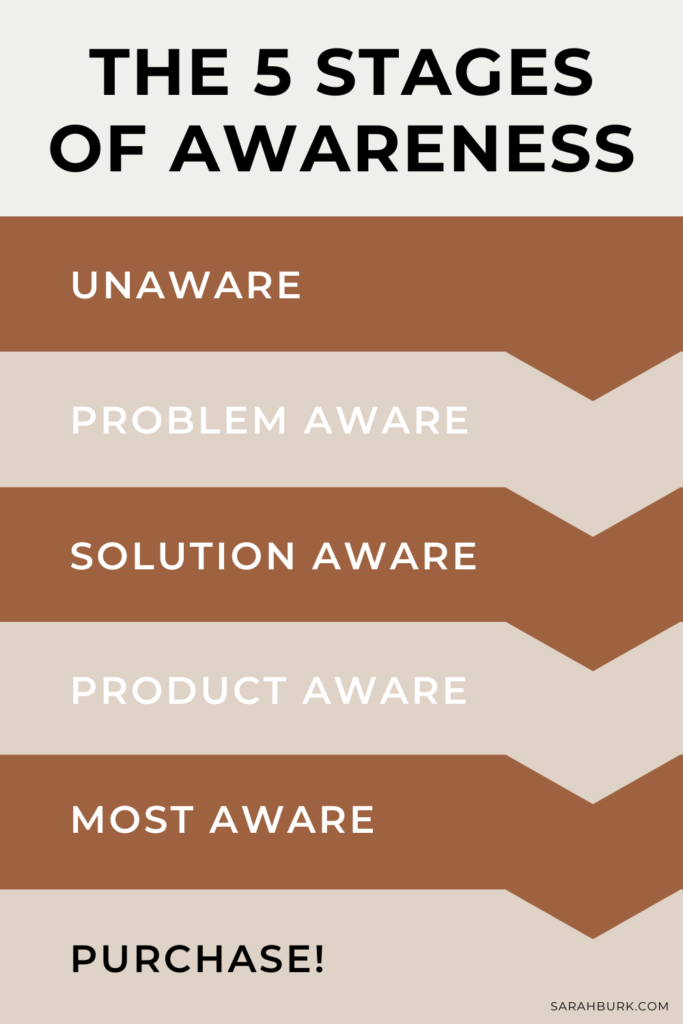If you’ve ever read any kind of marketing advice, you’ve probably heard about the 5 stages of awareness.
This concept was outlined by copywriter Eugene Schwartz and represents a consumer’s journey through the purchasing decision.
The 5 stages are as follows:
- Unaware
- Problem Aware
- Solution Aware
- Product (or Service) Aware
- Most Aware
They’re also commonly used to construct marketing funnels.
Knowing these stages of awareness is really important when it comes to crafting your Pinterest marketing strategy, because it differs from other components of your content marketing strategy.
Whereas on Instagram or even in your blogging strategy, the audience you interact with is likely solution or product aware, your Pinterest audience tends to hover in the problem-aware stage.
And this might be different for your ideal clients! So before you take what I say as fact, dig back into your target audience research and figure out where your clients mostly live.
But first, let’s get a quick overview of the stages so you can actually do that. Put your learning caps on because class is in session!
What are the 5 Stages of Awareness?
1. Unaware – Unaware consumers don’t know that they have a problem, let alone know any potential solutions. They’re stumbling across your content organically.
2. Problem Aware – Problem-aware consumers know that they have a problem, but haven’t started conceptualizing how to solve it. They’re experiencing some friction or difficulty in achieving their goals and are a bit lost.
3. Solution Aware – Solution-aware consumers know they have a problem, and know of one or several ways to solve it. But they don’t know what the best way is and haven’t decided which way to go. They’re also not yet aware of your particular service as the solution.
4. Product (or Service) Aware – Product-aware consumers know about your brand and that it’s an option to solve their problem, but they’re still comparing their options. This is your time to shine above the competition and make your service stand out.
5. Most Aware – Most-aware consumers know they have a problem, what the solution is, and that your service is the perfect fit for them. They just need one little push over the edge into that purchasing decision.

Why You Need to Know the Stages of Awareness
To be able to create content that reaches consumers at different stages of awareness and moves them through these stages, you need to understand what point of the journey they’re at.
Someone who knows they want to hire a Facebook ads specialist to help them generate more leads (product aware) isn’t going to resonate as much with content that continuously talks about the pain point of not knowing where to find leads (problem aware).
You might be targeting consumers at multiple different stages, which is why it’s important to have content that speaks to all parts of the journey.
It’s also important to understand the 5 stages of awareness because it gives us a common language to talk about your audience on Pinterest and how best to reach them.
Using the 5 Stages of Awareness in Your Pinterest Marketing Strategy
The general profile of a Pinterest user is that they’re using the platform to actively search for information or inspiration.
Whether they’re searching for branding inspiration or how to add a custom font to their Squarespace website, they’re on the platform with a purpose in mind.
They have a problem, and they might be aware of some potential solutions for it. This puts Pinterest users in the unaware to solution-aware stages.
Compare this to your Instagram followers or email list subscribers. Your Instagram followers probably know about your services, and maybe you’ve even chatted about working together in the DMs. They know that you’re a potential solution to their problem, but they’re just waiting for the right sign.
These people are in the product and most-aware stages.
Keep in mind, these are just generalizations, and they might not be 100% true in every scenario.
Knowing that Pinterest users are earlier on in their customer journey, how do you market to them?
Let’s look at an example to make things a little more specific.
Say your ideal client is a fitness coach and they’re trying to grow your business, but they’re stuck. They’ve got inconsistent income, not enough leads, and they’re not sure what needs to be fixed to make things click. They’re problem aware.
As a social media manager, you can write a blog about “How to Grow Your Fitness Coaching Business Using Instagram” and promote it on Pinterest. This kind of content is directing your ideal client that social media marketing is the solution to their current problem of growing their business.
Now, that same ideal client has been trying to promote their services on Instagram, but things still aren’t working. They’re not getting great engagement and aren’t converting followers to leads.
So you write a blog post about “5 Mistakes to Avoid on Instagram as a Fitness Coach”. When that ideal client goes to Pinterest to search for Instagram marketing tips, your educational content pops up in their search results and they begin to trust your expertise.
In those blogs, you’re also consistently including calls to action for the ideal client to engage further, to join your email list, to check out your services. You’re educating them about your products and services to move them towards that product-aware stage.
On Pinterest, you can also directly target this ideal client by promoting a freebie to help them plan their Instagram content. You may give them a preview of your services and follow up with an email nurture sequence that lets them know about your paid services.
From there, as you continually engage with that ideal client, they’re slowly moving through the stages of awareness. And since you’ve been with them since the beginning, they’re more likely to trust you when it comes time to hire.
Herein lies the true power of Pinterest – reaching your ideal clients before they even start looking at the competition.
By establishing yourself as the go-to source of knowledge for your dream clients, you’re building a strong foundation of trust that makes you the first service pro in mind when they decide to go from DIYing to outsourcing.
If you’re only creating content for the product-aware consumers in your audience, you’re missing a huge opportunity to capture large swaths of Pinterest users (aka leads) at the very beginning of their consumer journey.
Your Pinterest marketing strategy and content strategy are inherently intertwined. By its nature, Pinterest is a tool to promote your other content. So in order to create an effective Pinterest marketing strategy, you have to look at your content strategy first.
That’s why knowing the 5 stages of awareness is so important and why you need to be aware of your entire marketing funnel if you want to make the most of your Pinterest marketing efforts.
Need help with your Pinterest marketing funnel? Grab the free Pinterest Marketing Funnel guide to start identifying where you need the most support!
